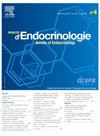Lipodystrophy and severe insulin resistance syndrome: Epidemiological data from a French national rare diseases registry
IF 2.9
3区 医学
Q3 ENDOCRINOLOGY & METABOLISM
引用次数: 0
Abstract
Context
Lipodystrophy and extreme insulin resistance syndrome are rare diseases with severe metabolic complications. Reported epidemiological data are conflicting.
Objective
We aimed to evaluate nationwide and regional prevalences of lipodystrophy and insulin resistance syndrome in France, and to study diagnostic and care-pathways.
Methods
We studied data from the French National Rare Disease Registry (BNDMR), which includes all patients attending rare disease reference centers in France. We analyzed demographic data and age at first signs and at diagnosis in patients with an ORPHA code of lipodystrophy or severe insulin resistance syndrome.
Results
The number of patients registered with lipodystrophy/insulin resistance syndrome doubled from 2017 to 2023, with the deployment of nationwide epidemiological tools in specialized rare diseases centers. Currently, 567 of the 652 patients (58% female) had a diagnosis of genetically determined disease with generalized (GL) or partial lipodystrophy (PL), giving an estimated national prevalence of 1.6 and 6.4 per million, respectively. Wide regional differences in estimated prevalence may be partly due to founder pathogenic variants, or local spread of clinical skills and knowledge. Median age at first signs and diagnosis were respectively 1 [IQR: 1–3] and 5 years [0–20] for GL, and 22 [14–35] and 40 years [25–52] for PL, with earlier first signs of PL in women than in men.
Conclusion
The estimated prevalence of genetic lipodystrophy/extreme insulin resistance syndrome has increases with the use of dedicated epidemiological tools, suggesting persistent underdiagnosis. Knowledge of these diseases needs to be improved to decrease diagnostic delay and reduce regional and gender-associated diagnostic disparities.

脂肪营养不良和严重胰岛素抵抗综合征:来自法国国家罕见病登记处的流行病学数据。
背景:脂肪营养不良和极端胰岛素抵抗综合征是罕见的疾病,伴有严重的代谢并发症。报告的流行病学数据相互矛盾。目的:我们旨在评估法国全国和地区的脂肪营养不良和胰岛素抵抗综合征的患病率,并研究诊断和护理途径。方法:我们研究了法国国家罕见病登记处(BNDMR)的数据,其中包括在法国罕见病参考中心就诊的所有患者。我们分析了患有脂肪营养不良或严重胰岛素抵抗综合征的ORPHA患者的人口统计学数据和首次症状和诊断时的年龄。结果:随着全国性流行病学工具在专业罕见病中心的部署,2017年至2023年登记的脂肪营养不良/胰岛素抵抗综合征患者数量翻了一番。目前,652例患者中有567例(58%为女性)被诊断为遗传决定的全身性(GL)或部分性脂肪营养不良(PL)疾病,估计全国患病率分别为1.6和6.4 /百万人。估计患病率的地区差异很大,部分原因可能是由于病原体的初始变异,或当地临床技能和知识的传播。GL的中位发病年龄和诊断年龄分别为1岁[IQR: 1-3]和5岁[0-20],PL的中位发病年龄分别为22岁[14-35]和40岁[25-52],女性比男性更早出现PL的首发症状。结论:遗传性脂肪营养不良/极端胰岛素抵抗综合征的估计患病率随着专用流行病学工具的使用而增加,表明持续存在诊断不足。需要提高对这些疾病的认识,以减少诊断延误并减少区域和性别相关的诊断差异。
本文章由计算机程序翻译,如有差异,请以英文原文为准。
求助全文
约1分钟内获得全文
求助全文
来源期刊

Annales d'endocrinologie
医学-内分泌学与代谢
CiteScore
4.40
自引率
6.50%
发文量
311
审稿时长
50 days
期刊介绍:
The Annales d''Endocrinologie, mouthpiece of the French Society of Endocrinology (SFE), publishes reviews, articles and case reports coming from clinical, therapeutic and fundamental research in endocrinology and metabolic diseases. Every year, it carries a position paper by a work-group of French-language endocrinologists, on an endocrine pathology chosen by the Society''s Scientific Committee. The journal is also the organ of the Society''s annual Congress, publishing a summary of the symposia, presentations and posters. "Les Must de l''Endocrinologie" is a special booklet brought out for the Congress, with summary articles that are always very well received. And finally, we publish the high-level instructional courses delivered during the Henri-Pierre Klotz International Endocrinology Days. The Annales is a window on the world, keeping alert clinicians up to date on what is going on in diagnosis and treatment in all the areas of our specialty.
 求助内容:
求助内容: 应助结果提醒方式:
应助结果提醒方式:


